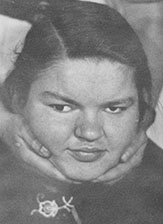Search for Names, Places and Biographies
Already layed Stumbling Stones
Suche
Helga Meyer * 1918
Stiegstück 3 (Wandsbek, Hummelsbüttel)
HIER WOHNTE
HELGA MEYER
JG. 1918
EINGEWIESEN 1941
ALSTERDORF
"VERLEGT" 16.8.1943
AM STEINHOF WIEN
ERMORDET 11.9.1944
Helga Meyer, born on 3 Oct. 1918 in Bremen, admitted to the then Alsterdorf Asylum (Alsterdorfer Anstalten) on 23 Sept. 1941, "transferred” to the Vienna Municipal Wagner von Jauregg-Heil- und Pflegeanstalt, a "sanatorium and nursing home,” on 16 Aug. 1943, murdered on 11 Sept. 1944
Stiegstück 3
Helga Gerda Bernhardine Meyer died on 11 Sept. 1944 at the age of barely 26 years in the Wagner von Jauregg - Heil und Pflegeanstalt of the City of Vienna. She had been transported to Vienna from the then Alsterdorf Asylum together with 227 girls and women on 16 Aug. 1943. By the end of 1945, 196 of them had perished, most probably due to malnutrition, neglect, lack of treatment in case of illness, and deliberate overdosing of medication.
Helga Meyer was the second daughter of the merchant shipping captain Johann Gerhard Meyer, born on 14 Feb. 1886 in Geestemünde (today a district of Bremerhaven), and his wife Ella Johanne Auguste, née Martens, born on 24 Apr. 1892 in Waddens, today part of the municipality of Butjadingen in the Wesermarsch administrative district. Johann Meyer and Ella Martens had married in Bremen in Oct. 1912. Their first daughter Anneliese Katharine was born on 30 July 1913.
Anneliese and Helga were baptized Protestants.
We do not know when the family settled in Hamburg or its environs. In any case, in 1936 the Meyer couple bought the property at Stiegstück 3 in Hummelsbüttel, a former Prussian village on the Upper Alster (Oberalster), which became a part of Hamburg on 1 Apr. 1938, as a result of the Greater Hamburg Act. After the couple had built a single-family home on the property, they lived there with their two daughters.
Helga had sustained a fall as a child. When she was eight years old, she showed signs of illness, possibly the consequences of the fall. Helga had learned to walk only late and with great difficulty. Speaking gave her trouble. Her stays in the so-called cripple home of "Alte Eichen” and in the Eppendorf General Hospital in 1930 do not seem to have led to an improvement in her health.
Helga attended two classes of the eight-grade elementary school (Volksschule). She could read and did so often and with pleasure.
Over the years, she lost the ability to take care of herself. When she was admitted to the then Alsterdorf Asylum on 22 Sept. 1941, she was described as completely in need of care; she had to be washed, combed, dressed, and could not eat by herself. Reportedly, she was patient, grateful, tolerant, and cheerful at the same time.
After the Alsterdorf Asylum had sustained damage during the heavy Allied air raids on Hamburg at the end of July/beginning of Aug. 1943 ("Operation Gomorrah”), the director of the Alsterdorf Asylum, Pastor Friedrich Lensch, took advantage of this situation and asked the Hamburg health authorities to evacuate about 750 institutional residents because they had been made homeless by the bombing. As a result, between 7 and 16 Aug. 1943, four transports with a total of 469 girls, boys, women and men left Alsterdorf in various directions, including the 228 girls and women on 16 Aug. 1943 with the destination Vienna. Helga Meyer was also in the latter transport.
The treatment of the patients in Vienna was not guided by their welfare. Thus, reports indicated that they had eaten potato peelings because of hunger.
Helga Meyer’s mother tried to maintain contact with her daughter by letters and parcels. She also sent money to Vienna in the hope that it would benefit her daughter, but rarely received information about her.
In Mar. 1944, Dr. Hans Bertha, one of the T4 evaluators of the Nazi "euthanasia” program, informed the parents that Helga was bedridden due to paralysis. In July of the same year, they received the news that Helga’s health had deteriorated. Allegedly, her lungs had been affected. Helga Meyer died only one and a half months later, on 11 Sept. 1944. Her mother learned by telegram that Helga had died of pulmonary tuberculosis, which had been rapidly progressing since the middle of the year and was a frequently cited cause of death, covering up deaths by force.
When the news of Helga’s death reached Hummelsbüttel, her father was at sea. Her mother had to cope with this second stroke of fate alone, after Helga’s 31-year-old sister Anneliese had already died on 24 July 1944.
Helga Meyer’s body was cremated in Vienna. The urn was to be buried at the cemetery in Hamburg-Ohlsdorf at her mother’s request. However, no confirmation of this could be found in the Ohlsdorf cemetery records.
Translator: Erwin Fink
Kindly supported by the Hermann Reemtsma Stiftung, Hamburg.
Stand: September 2020
© Ingo Wille
Quellen: Staatsarchiv 332-5 Standesämter 9953 Sterberegister Nr. 1151/1944 Anneliese Meyer, 1301 Sterberegister Nr. 1042/1950 Johann Gerhard Meyer; Ev. Stiftung Alsterdorf Archiv Nr. V151; Michael Wunder, Harald Jenner, Hamburger Gedenkbuch Euthanasie Die Toten 1939-1945, Hamburg 2016, S. 284 f.
Zur Nummerierung häufig genutzter Quellen siehe Link "Recherche und Quellen".


